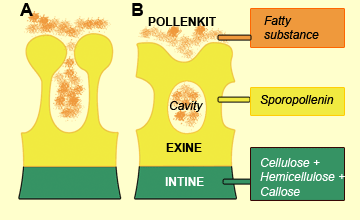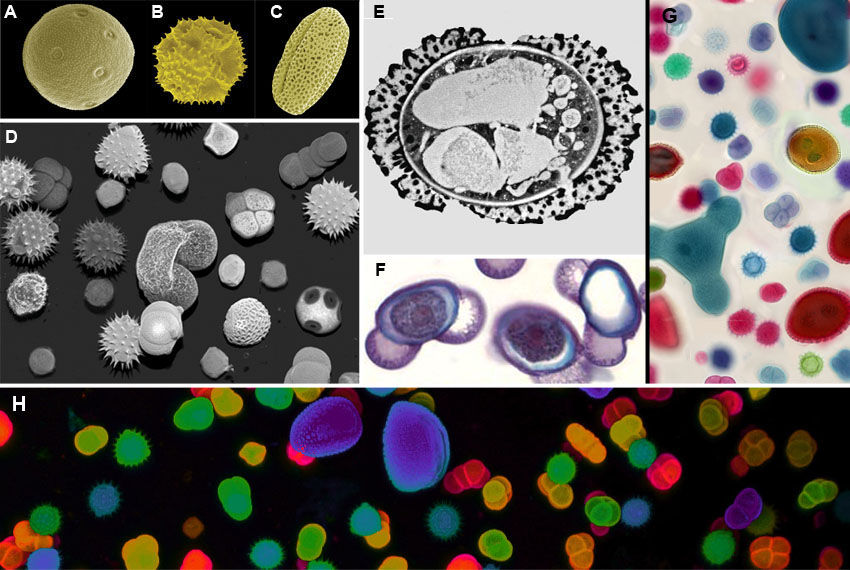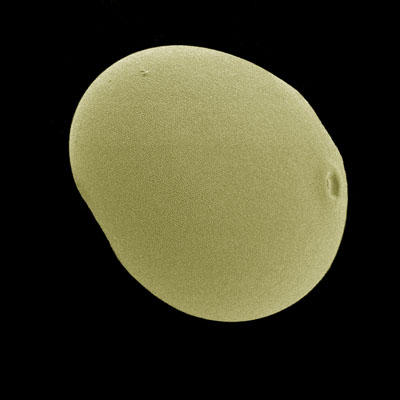Pollen grains of various species can vary quite a lot in size (from about 10 to nearly 100 micrometer; exceptions are the thread-shaped pollen grains of some eelgrass) and in aspect: round, ovale, disc or bean-shaped and somtimes filamentous. The natural color is mostly white, cream, yellow or orange. The texture of the cell wall shows also great varietions, from smooth to spiky (see here below).
Cell wall of pollen grains
The wall of the pollen grain always consists of two layers: the inner intine wall and the outer exine wall. Both inner and outer cell wall of pollen grains often have a typical structure that depends on the species. The deposition of these walls begins already during meiosis and continues until final maturation of the pollen grain. The inner layer is laid by the cells themselves, the outer wall is deposited by the tapetum (t in figures on
pollen development).

The inner wall consists of cellulose and hemicellulose, but callose is always present (see fluorescing
callose labeling of pollen tubes). Callose is nearly absent in "normal" cell walls. The outer wall consists mainly of sporopollenin, a mixture of stable biopolymeres containing a.o. fatty acids. Sporopollenin protects the living vegetative and generative cell in the pollen grain against mechanical damage, chemical break-down and too rapid dessication and it provides a shield against the agressive ultraviolet radiation of the sun. On the surface of the outer wall and in cavities remnants of the tapetum can be found. Sometimes the grain is covered by a liquid, fatty substance, so-called "pollenkit". Intine, exine and cytoplasm can all three contain allergens that may cause
hay fever.
The outer wall consists always of a closed lower layer (foot layer) covered by a very variable species-specific stratification. An intermediate layer of columns (bacula or columella) is often observed which lay in a regular pattern. These columns are generally enlarged on the upper side (see diagram here above), so that they make contact with each other and build a kind of roof (tectum) that gives rise to liniar or reticulate patterns, like in
Arabidopsis thaliana. Sometimes they form a more or less solid surface bearing cavities (lumen). Above the tectum other ornamentations may occur in the shape of rains, points, spikes and ribs with.
So-called colpi (elongated aperture) and sometimes small germination pores often indicate the spots where pollen grains will germinate. In these areas an outer wall is often absent and the inner wall is very thin, but sometimes just very thick. When a germination pore exists, a little cover of outer wall may occur, the operculum.
Pollen observation with a microscope
Pollen grains are very small; therefore the use of a light or electron microscope is required to observe them. Here below examples are shown of various types of microscopical views:
| Various types of microscopical views of pollen grains |
 |
A Ribwort Plantain (Plantago lanceolata), B Dandelion (Taraxacum sp.) and C Arabidopsis (Arabidopsis thaliana): Scanning electron microscopy (colorized)
D Mixed pollen grains: Confocal Laser Scanning Microscopy (shadow projections of z-series)
E Arabidopsis (Arabidopsis thaliana): Transmission electron microscopy
F Pine (Pinus sylvestis): Light microscopy
G Mixed pollen grains (bright field light microscopy, stained)
H Mixed pollen grains (autofluorescence in confocal laser scanning microscopy: depth color-coded z-projection)
|
Pollen recognition
In order to recognize pollen grains a number of characteristics are taken into account:
- Size and shape
- The number of colpi and/or germination pores and their position
- The structure of the cell wall
Here below some of these properties will be discussed using examples (more about
Pollen determinatie) . With help of such characteristics it is sometimes possible to find out which species of pollen was involved, but often the search stucks at the level of the plant family. Determination of pollen is a major help for people who suffer of hay fever; by means of pollen forecasts on the radio, television and on the internet they can take preventive measures during periods where pollen to which they are sensitive is abundant in the atmosphere (more hereabout on
pollen allergy: plants & weather and
pollen allergy: mechanism). Pollen diagrams of soil samples are used in archeology to obtain indications on the landscape and about the habits of its inhabitants in certain periods (see for example results from
pollen diagrams revealing the impact of the Romans on the woods near Nijmegen). Pollen analyses are also most valuable for geological and climate research purposes: pollen give precise and rliable data on datation and the vegetation and the growth conditions. In historical research pollen can contribute to gain information on nutritional habits of human and animals and on the origin of some objects. Pollen determination is also applied in forensic investigations.
| Morphological characteristics of pollen |
 |
 |
Copyright on all photographs: Jan Derksen
|
Webpages and photographs:Jan Derksen and Elisabeth Pierson
Drawings: Lidwien van der Horst
Web development: Remco Aalbers
More on pollen anatomy: Science and Plants for Schools (microscopic images of many species)







